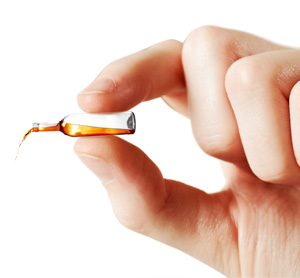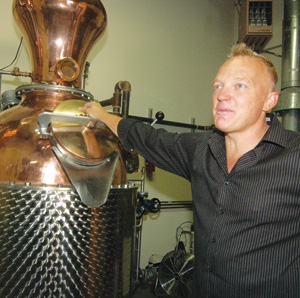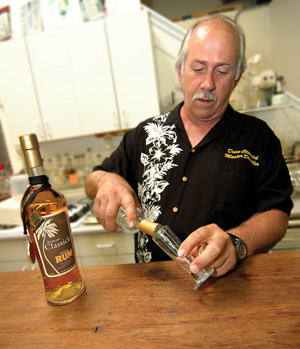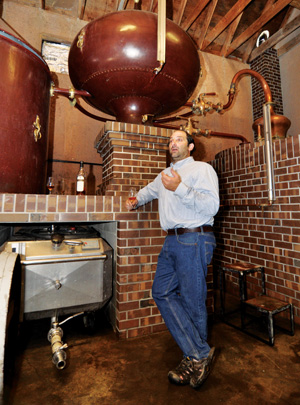IF ALL goes well, Dan Farber’s grandchildren will raise a glass and toast him for a job well done. But that’s a long way off. His kids are still in grade school, and he doesn’t have any grandchildren yet. But Farber, 48, is working for the ages. The fruits of his labor are meant to outlast him.
We’ve all heard of slow food or even slow money. But how about slow booze? Farber is a distiller. He makes brandy under his Osocalis label in a barnlike distillery behind his house in Soquel.
Farber is part of an exploding movement of craft distillers in America who are creating small batches of distinctive, handmade spirits that are the antithesis of the mass-produced liquor that dominates the shelves of bars and stores. And like the microbeer and premium wine industries that came before it, craft distilling has deep roots in Northern California.
Brandy is a spirit distilled from wine. Like most red wine, brandy only takes on its true character after years spent in oak barrels. There’s no way to speed up the process.
“The old saying is: the best time to start making brandy is 10 years ago,” says Farber, an intense, enthusiastic man with a stubbly beard who drops French words as easily as he drops the f-bomb in his New York–inflected English.
“It takes a really long time to make a great brandy. The brandies we make today are for sale 10 years from now.”
And great brandy is what Farber has set out to make. He explains that the cool 2010 growing year is shaping up to produce the best vintage in 20 years. So if you’re in the market for brandy in another 10 years, keep your eye out for Osocalis.
Osocalis, the Native American word for Soquel, sells three different kinds of brandy. The “rare” is at least 7 years old. The “XO” is 14 years old or more. The soon-to-be-released “heritage” brandy is at least 2 decades old. (Brandies of different vintages are often blended together.)
I tried all three, and my favorite is the XO. It has a softer, rounder feel in the mouth than the rare brandy, but what sets it apart is its haunting, hard-to-name flavors—dried orange? vanilla? cocoa?—and complexities. The brandy has a finish that seems to go on forever. It’s a spirit that invites contemplation about life, love and beauty.
Like most distillers, Farber works alone. Distilling is a solitary job. As dusty rays of light filter into his distillery, his morose-looking Vizsla dozes on the dusty floor, occasionally snapping at a droning fly.
The distillery has two copper alembic stills made in France just for him. The dark purple, three-chambered contraptions look positively 18th century.
Indeed, the technology is ancient. Wine is heated in a boiler, and the rising vapor floats up a delicate goose neck and then passes through an Aladdin’s-lamp-like vessel called the pre-heater. Then it moves into a condenser; the vapor comes in contact with a long coil where the vapor condenses into brandy. Once that’s done the spirit is dribbled out and then added back to the boiler to repeat the process all over again.
Brandy is distilled twice. It takes about 10 barrels of wine to produce one barrel of brandy and capture the essence of the wine in the spirit. Making one barrel of brandy takes about a week.
After the second distillation, the brandy is barreled and put into the cellar or “chai.” And there it sits. A brandy right out of the still is recognizable as brandy, but it’s clear and hasn’t taken on the tawny color and supple, complex flavors of well-aged brandy. A well-made brandy can age 50 years or more.
“I may live long enough to see some of my brandies go to majority,” Farber says.
Some of the barrels are garlanded with spider webs. The spiders eat oak-boring weevils that would otherwise endanger the spirits. In between the rows of barrels hang two legs of pork destined to be prosciutto, another one of Farber’s long-term projects. The roof of Farber’s distillery is stained a sooty black from an alcohol vapor–loving mold that’s taken up residence on the shingles, a tell-tale sign of what’s going on inside.
Farber is passionate about brandy because in addition to producing a spirit of uncommon beauty and finesse, brandy distilling is a way of preserving California’s agricultural lands from development.
“We’re here because the fruit and climate are here,” he says. “This distillery is set up to do something well.”
A Family Tradition
No one gets into the craft of microdistilling to make money. The money may come, but distillers are moved by a passion that calls to them. Distiller Davorin Kuchan left his career in high tech (like so many vintners before him) to pursue something that had deeper meaning for him.
A native of Zagreb, Croatia, Kuchan spent his youth picking grapes and making wine and spirits from his family’s vineyards, sweet memories that he still savors.
When his parents passed away a few years ago, he decided he wanted to preserve his family’s heritage and continue making handcrafted spirits. Kuchan, who immigrated to the United States in 1985 and still has a trace of his Slavic accent, has hung pictures of his family on the wall of his Old World Spirits distillery in Belmont. His work is really an ode to them, particularly his mother.
Other pictures show his daughters stomping pears for his outstanding Poire William eau de vie. All fruit is organically produced and the distillery is certified organic, too.
“This is very much a family affair,” he says. “For me this is not what I do. It’s who I am.”
It’s hard to say what product constitutes Old World Spirits’ flagship. I tasted my way through Kuchan’s product line (at 10:30am, no less), and it was all stunning.
Kuchan says there are about 25 pounds of fruit packed into each bottle of his eau de vie. But if you’re thinking of cloying, sticky-sweet alcohol, you’re in for a delicious surprise.
Kuchan makes two kinds of peach brandy and one pear brandy. Each is supremely smooth and delicate with lush, perfumed fruit flavors and a finish that seems to go on forever. The oak-aged O’Henry peach eau de vie is ridiculously good. The toasty, creamy vanilla flavors of the oak join forces with the floral, fresh fruit flavors of the peaches to make an uncommonly smooth and rich brandy. You could blend these into a cocktail but Kuchan says he makes them to stand alone. And that they do.
His Blade gin leads with complex, clean flavors of citrus and spices instead of the forest of juniper that defines most mass-produced gins. It’s refreshingly delicious.
And then there’s La Sorciere, his green and white absinthes, bewitchingly delicious spirits that feature an eerie drawing of a chalice-clutching fairy penned by his daughter. Once illegal in the United States, absinthe has enjoyed a revival, but Kuchan says he isn’t chasing trends.
The herb-infused brandy has long been available in Croatia, and Kuchan says he’s simply following an old tradition. Both his white (the first of its kind in the United States) and green absinthes reveal layers of aromatic, minty flavors, but at 100 proof what gets me is their incredible smoothness and complexity. These are beguiling spirits built to last.
An industrial park in Belmont is an unlikely place to go for a drink, but one Friday a month, Old World Spirits opens its doors to the public and offers a taste of some truly outstanding gin, fruit-flavored brandies and absinthe handmade in a custom, German-made copper still right on the premises.
Old World Spirits’ products are available at Lunardi’s markets, Draegers, K&L in Redwood City and Beltramos Wine and Spirits in Menlo Park as well as Cin Cin in Los Gatos and the Plumed Horse in Saratoga.
Stillwater Runs Deep
For Stillwater Spirits’ Phillip Ladner, you could say alcohol is in his blood, literally and figuratively. A native of Mississippi, Ladner, 30, grew up near the town of Kiln, a city that was once known as the moonshine capital of the United States.
His sister is vice president and marketing manager for Broadbent Selections, an importer of wines from small, family-owned wineries. His brother-in-law is the drinks columnist for The New York Times. And his aunt and uncle run Paso Robles’ Dubost Family Ranch winery.
“If we’re not making it or selling it, we’re drinking it,” Ladner says.
He took over distilling duties at Petaluma’s 7-year-old distillery just a few weeks ago. The distillery runs three stills, but the soul of the operation is a 500-gallon Armagnac-style pot still made in Kentucky.
“It’s a dream of mine to have this position,” he says, before running off to check on a batch of brandy.
There’s no school for learning how to be a distiller, but Stillwater offers a class in cooperation with the American Distilling Institute to teach people the basics of the craft. It costs $3,500.
In addition to brandy, Stillwater makes vodka, gin, grappa (brandy made from pressed wine grapes) and eau de vie. The distillery also has whiskey, bourbon and rye in the cellar that’s due to be released later this year.
“We’re just waiting for the right flavors to come together,” Ladner says.
The vodka is unique. It’s made with 100 percent malted barley, the same ingredient that is used to make whiskey. Indeed, Ladner calls it a whiskey drinker’s vodka.
“We like to tell people to drink it straight up,” he says.
Ladner attributes the rise in popularity of small-scale, craft distilleries to a general shift toward local, artisan-made products, be they cheese, beer or bread.
“People are really wanting to do local products again,” he says. “Right now it’s really rolling.”
Penn Jensen, vice president of operations for the American Distilling Institute, a microdistilling trade group based in Hayward, says the industry is growing about 20 percent to 30 percent a year. When the group published its member directory in 2005 there were 69 distilleries listed. Today there are 198. He attributes the growth to lifestyle and business opportunity.
“People want to know what they’re drinking,” Jensen says. “There’s been a disavowal of the factory model of industrial food.”
This shift in consciousness has sparked the imagination of creative, often iconoclastic individuals who aspire to do something different, he adds. “It’s the sense of opportunity that can really fire up the entrepreneurial mind.”
A Distilling Dynasty?
At another bland industrial park in Mountain View, Dave Classick of Essential Spirits isn’t rekindling a family tradition, he’s creating one. Like Kuchan of Old World Spirits, Classick is another high-tech refuge who longed for something more fulfilling than toiling for a large corporation.
Classick works with his son Dave Classick Jr. to create a line of premium spirits, vodka, rum, gin, grappa, eau de vie and bierschnapps, an obscure spirit made from faintly hopped pale ale (“it’s like drinking a six-pack in a shot glass”).
His dream is to create a “family distilling dynasty.” One hundred years from now, he hopes people will still be enjoying a glass of Essential Spirits. An industrial park may seem like an inauspicious place to start, but a dynasty has to begin somewhere.
All Classick’s products are made from a custom alembic still built by a third-generation still maker in France.
“It’s the product of a single craftsman’s hands,” Classick says. So are his spirits.
Although he looks a bit like a Jimmy Buffet fan with his bushy mustache, Hawaiian shirt, shorts and Adidas sandals, he is serious about the craft of distilling. In his past life he was a quality control and industrial engineer for HP. He’s taken the rigor that job required and applied it to distilling.
“Quality begins at the beginning,” he says. “You can’t put it in later. It doesn’t work that way.”
Take his grappa, for example. Most grappa I’ve tried is as rough as kerosene. It’s not worth drinking. But Classick seeks out pressed grapes from some of California’s premier wineries just after crush. From them, he makes spirits in which you can actually appreciate that they’re a product made from grapes with delicate flavors and aromas and a finish that goes on and on.
As good as the grappa is, it’s the rum that really made me sit up and take notice. Most rums are made from Central American or Caribbean molasses, but Classick makes his from molasses he gets from Kauai.
He says the volcanic soil and altogether different terroir make for a deeper, richer flavor—like butterscotch.
The gold rum is superb. It’s meant for sipping, not mixing. It’s not barrel aged, but Classick dangles oak-wood staves in the rum to impart color and toasty vanillas notes. The rum is called Sergeant Classic because Classick served in Vietnam, where he earned a chestful of medals, including the Bronze Star and the Gallantry Cross. His specialty was walking point on jungle patrols, a deadly job that often got people killed. Classick liked it, and he was good at it.
But that was a long time ago. Now he enjoys getting up before dawn to cook up a new batch of spirits.
“It’s a very serene discipline, he says. “I usually listen to Haydn or Mozart when I’m distilling. There’s a certain mystery about it, the transformation of this fruit or grain into a magic elixir.”
Osocalis Distillery www.osocalis.com
Old World Spirits www.oldworldspirits.com
Stillwater Distillery 707.778.6041
Essential Spirits www.essentialspirits.com






